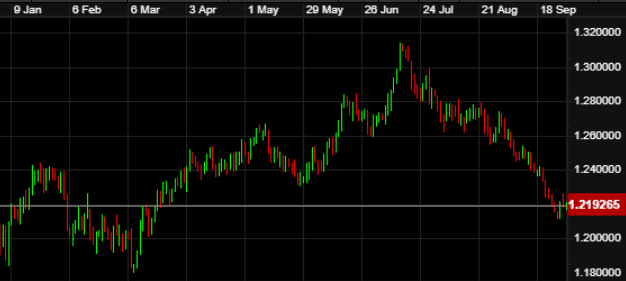ACM Update 02-10-23

Pretty much all European and US news last week, and that was before the Ryder Cup had even started in Rome! The Dollar now has a run of eleven straight weeks of gains versus the Euro, such is the might of the greenback at present. It begs the question, when will that run end?
In the UK, data was light but Rishi Sunak is in the limelight as his pledge to cut taxes seems to be getting kicked down the road. All this with the Tory Party Conference taking place in Manchester this week, amidst a raft of “unfortunately timed” rail strikes. Not the best look for the PM…..
Ten weeks last week, now eleven weeks this. The Dollar strength continued as we closed out September with gains of 6% plus against Sterling and the Euro in Q3. Over the weekend, the US Government shutdown has been the main economic talking point, as once again the debt ceiling was raised with a short-term bill, ensuring funding through until 17th November. The deal was agreed by both the House and Senate, then signed into law by Joe Biden minutes before the midnight deadline.
This was all despite a suspiciously-timed fire alarm evacuation, and a series of rapid rearrangements including a lack of further aid to Ukraine. It will be interesting to see if the picture of political instability will harm the Dollar this week, as in the run-up to the vote last week we did see some USD weakness.
Improving US-China relations also seemed to have had a detrimental effect on the Dollar last week, off the back of more traction globally for China as an economic superpower. In terms of economic data, US Final GDP numbers for Q2 showed a growth of 2.1% versus Q1, a fraction lower than the 2.2% forecast. Still, this outperforms many other major global economies.
US consumer confidence also came in worse than expected, according to the Conference Board. But despite all this, the unemployment sector remains buoyant with jobless claims lower than expected again last week. The jobs picture continues with Non-Farm Payrolls and Unemployment this Friday.
The Dollar reached its strongest position against sterling since March 2023, as the Bank of England rate announcement from the week before weighed heavily on the pound. There was a bounce later in the week though, retracing over 1% by Friday. Moves over the year to date can be seen in the chart below.

A slightly better week for the Eurozone last week, despite a mixed bag of data behind it. Christine Lagarde opened the week in Brussels with a speech at the ECB’s Committee on Economic and Monetary Affairs. During this she reaffirmed that recession is not “part of the baseline scenario”. This was likely to reassure markets, as the mere mention of the word at the last ECB meeting caused jitters.
The ECB President also painted a picture for the upcoming meeting minutes, confirming that policymakers are not talking about rate cuts at this stage. Such words were still not enough to prevent further Euro slides though.
The Flash CPI data released on the last day of the month showed Eurozone-wide inflation is forecast to have fallen back to 4.3% from 5.2% last month. Quite a marked drop, given that many other economies have seen a jump in fuel prices of late causing inflation to notably bounce back up.
Indeed, Spanish inflation figures, released on Thursday, showed a jump back to 3.5% from 2.6% the previous month. This comes mainly as the cost of electricity bounced in September, after a fall 12 months ago also not helping the data. Fuel prices also rose in Spain during the month, as elsewhere.
Back to German data which remains disappointing and concerning. Retail sales data showed a month on month drop of -1.2%, import prices rose (albeit a little less than forecast) and month on month inflation is expected to go up by 0.3% for September. The German IFO business climate meanwhile (essentially a measure of confidence from manufacturers, retailers and wholesalers), hit its lowest mark since October of last year. Troubling times and still very much a concern for the overall Eurozone picture going into the winter.
As already noted, UK data was light last week. The Final GDP figure from Q1 to Q2 confirmed an economic growth of 0.2%, whilst the previous quarter was revised up to 0.3%. The UK is just keeping its head above the water for now in avoiding recession.
The property market though is definitely facing a tough time with prices falling. Mortgage approvals data saw the lowest number of approvals in six months during August, a third monthly decline in a row.
For this week, the focus will shift onto Rishi Sunak and the Tory Party Conference taking place in Manchester. News over the weekend was not favourable for the PM, coming under fire on taxes, the cost of living, not to mention HS2 and rail strikes. Expect confidence in the Tory party to be a key GBP driver this week.
Last week’s GBP-EUR movements can be seen below:

The other major release last week was Australian inflation, where figures showed a bounce back to 5.2%, up from 4.9% previously. This fuelled a slight resurgence for the AUD, on the basis that the Reserve Bank of Australia may now not be done with their rate hikes. Thus, another becomes possible/likely in their next meeting this week, in the early hours of Tuesday.
This week:
Monday – China Bank Holidays (ALL WEEK), Australia Bank Holiday, Canada Bank Holiday, Eurozone/UK/US Manufacturing PMI data (08:15-15:00 UK time), Eurozone Unemployment rate (10:00), Catherine Mann speech (16:00), Jerome Powell speech (16:00)
Tuesday – Australian interest rate announcement (04:30), German Bank Holiday
Wednesday – New Zealand interest rate announcement (02:00), UK/EU/US Services PMI data (08:15-15:00), Christine Lagarde speech (09:15), ECB Retail Sales (10:00), Christine Lagarde speech (17:00)
Thursday – UK Construction PMI (09:30), US Unemployment Claims (13:30)
Friday – German Factory Orders (07:00), Non-Farm Payrolls & Unemployment Rate (13:30)
A new week, a new month and a new quarter…. We find ourselves with the usual raft of PMI data releases to start the month. Besides that, UK data releases are thin on the ground and the majority of the focus will be on Wednesday’s Christine Lagarde speeches and then Friday’s Non-Farm Payrolls/Unemployment data. Dollar data continues to perform well towards the desired soft landing, and this will be another indicator. One of the bigger Dollar events of the month.
Elsewhere, interest rate announcements in Australia and New Zealand will make an appearance midweek. The Reserve Bank of Australia it would seem have the closer decision, with a notable bounce in inflation back to 5.2% meaning another rate hike (from the current 4.1%) could well be on the cards. In New Zealand, interest rates are expected to remain at 5.50%.
For now, the Euro remains very much on the back foot especially versus the Dollar. Sterling is somewhat flatlining and movement will be driven by the ups and downs of the Tory Party Conference this week more than anything else. For those selling USD, we are still presented with excellent prices to convert back to GBP.
Reach out to the team with any pending requirements and we will be glad to assist.
Have a great week, month and Q4!